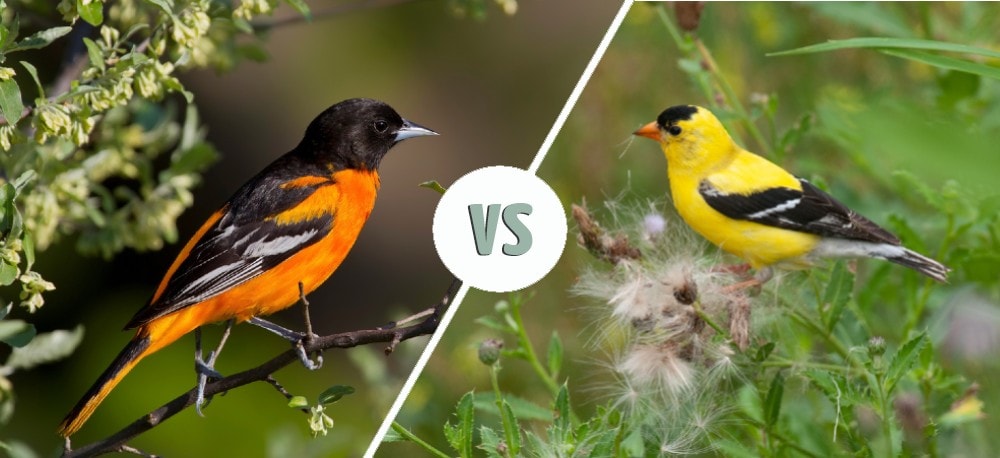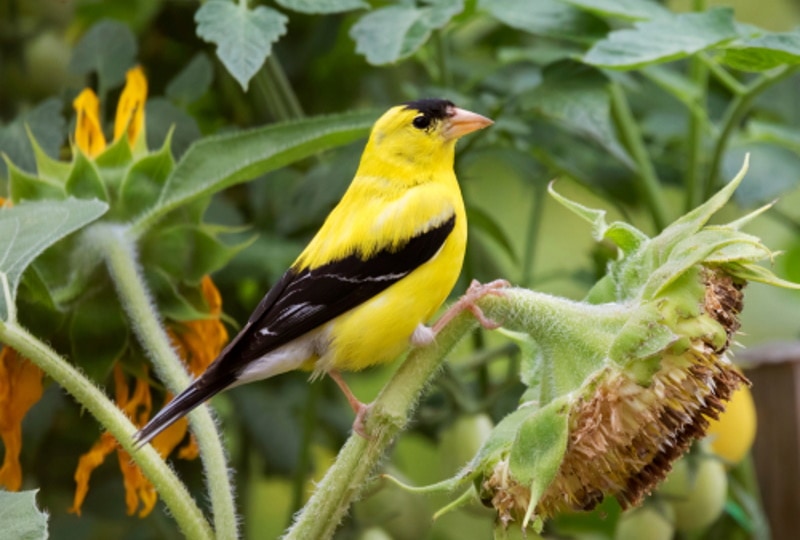Oriole vs Goldfinch: How to Tell the Difference
Last Updated on

Colorful birds have to be the most eye-catching animals on the planet. There are quite a few that stand out, and both the oriole and goldfinch are well-known species displaying warm, bright hues. These North American aerial critters may be mixed up from time to time, as they do have some striking similarities.
However, it all depends on certain variables we’ll discuss more soon. Luckily, we’ve gathered some knowledge will improve your identification accuracy for both the oriole and goldfinch. We’ll cover visual and physical characteristics, behaviors, and habitats. You won’t need to second-guess after this article.
Let’s get into it!

Visual Differences

At a Glance
- Origin: North America
- Size: 6.7″ to 7.5″
- Lifespan: 11.5 years
- Domesticated?: No
- Origin: North America
- Size: 6.7″ to 7.5″
- Lifespan: 11.5 years
- Domesticated?: No

Oriole Overview

Characteristics and Appearance
Baltimore orioles are foliage gleaners, hunting for insects among the leaves, but they may also treat themselves to fruits. They live in dense forests and nest in trees where they can stay protected from predators.
Similar to the size of a robin, orioles have sharp gray beaks as well as gray legs. The male oriole is famed for its vibrant orange and yellow belly, and this orange can even look red in many cases. They also have a sleek black head and back, with some white, gray, and black accents that can be seen on their wings. On the other hand, female orioles look much different than their male counterparts. Although they share the same gray beaks and legs, female orioles are mostly yellow, with a tad bit of orange on the breast. Their wings and back are covered in a mix of brown and white tones.

Regions and Migratory Patterns
The oriole is mainly found in the eastern U.S. but has a range spanning as northern and western as Alberta for the breeding season. It’s possible to see orioles all the way down at the northern tip of South America, with many other migratory destinations in the tropical regions of the United States and Central America.

Goldfinch Overview

Characteristics and Appearance
The American goldfinch seeks a diet of seeds and light vegetation that can be found on leafy plants and trees. They are easy to attract to the backyard due to this, and they don’t stray away from their preference for open wooded areas.
Goldfinches boast a striking yellow color, which is especially the case for males. This is complemented by a dark black cap and blackish-white wings. The female goldfinch still retains some of this yellow prominence but does not display the same black cap; but rather a yellow head that is evenly colored. A female goldfinch’s body is a splatter of brown, yellow, white, and gray. Their wings have a higher ratio of whites to blacks than males.

Regions and Migratory Patterns
You can find goldfinches in just about every corner of the United States, and you can even find them in the northeast of Mexico or along the U.S.-Canadian border. However, their northern habitats are temporarily used for mating season. In about half of the states (mostly in the north and the central U.S.), they can be found year-round. But the other half that’s concentrated in the south is a non-breeding ground.

What Are the Differences Between Orioles and Goldfinches?
Visual
The only time where you will see similarities in the looks of these species is when you examine a female oriole and a female goldfinch. They both have a yellow body with a brownish-white back. However, you can quickly separate them, as the oriole has brown and white wings, but the goldfinch has black and white wings. Also, the goldfinch seems to stand slightly taller. Males of both species have distinctly different color patterns too, so it shouldn’t be a challenge in that regard.
Behavioral
Although they are both forage foliage, orioles are omnivorous, whereas goldfinches are vegetarian. Not only that, but where they get their food is a bit different. Orioles live in a variety of forest environments, but the other is fond of open forests. Plus, the goldfinch nests in shrubs, as orioles live higher up in the canopy. Goldfinches are also much more common at the feeder, as they are always up for a feast of sunflower seeds. Orioles still have a lot of prominence in suburbia though.

Range
If you’re on the western U.S. and the Pacific Coast, you’ll only be able to see goldfinches in this region. But once you get into the central and eastern states, you may see them in the same spots.
Other
These may seem trivial, but we threw them in as a little bonus. The oriole has its state bird status only in Maryland. There are three states that the goldfinch represents; New Jersey, Iowa, and Washington.

Final Thoughts
Orioles and goldfinches are beloved birds that many call their favorites. With extraordinary colors and modest populations in the U.S., they can sometimes be mistaken in some circumstances. However, after reading a few of our identification tips and their differences, this removes most of the doubt. The main takeaway is that their wings and behaviors aren’t the same. Make sure to use binoculars to get a closer look so you can be sure of what you see.
Happy birdwatching!
Featured Image Credit: (L) John L. Absher | (R) Nancy Bauer, Shutterstock
About the Author Robert Sparks
Robert’s obsession with all things optical started early in life, when his optician father would bring home prototypes for Robert to play with. Nowadays, Robert is dedicated to helping others find the right optics for their needs. His hobbies include astronomy, astrophysics, and model building. Originally from Newark, NJ, he resides in Santa Fe, New Mexico, where the nighttime skies are filled with glittering stars.
Related Articles:
Monocular vs Telescope: Differences Explained (With Pictures)
Holy Stone Drone Review of 2024 – Pros, Cons, and Verdict
Ultraviolet Light vs Black Light: What’s the Difference?
Light Waves vs. Sound Waves: The Key Differences
Infrared vs. Thermal Cameras: How Are They Different?
Far Infrared vs Near Infrared: What’s The Difference?
Mottled Duck vs. Mallard vs. Black Duck: What’s the Difference?
Shutter Speed vs Frame Rate: Pros, Cons, & Difference
